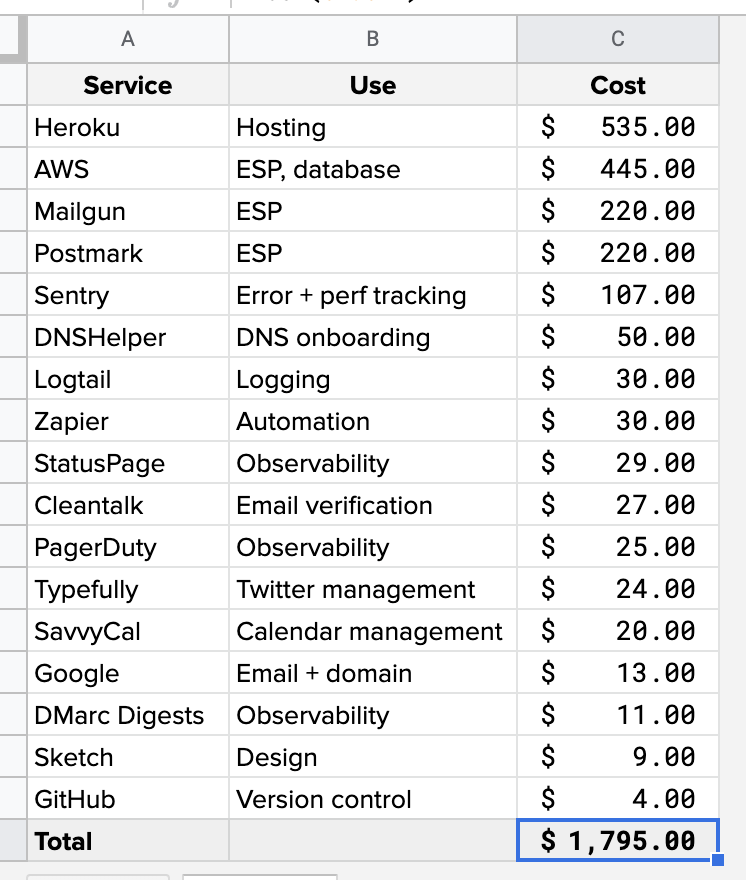What it costs to run a software business in 2023
A rundown of Buttondown's software costs for the year.
I am a sucker for a good list of running costs, dating back to seeing Cushion's, back in 2015. I think it lends an earnest and unglamorous look as to what it really takes to a business in the way that "hustle porn"-type essays rarely do.
I've done a poor job of keeping my own such running cost document (though I'd like to do a better job!), but in lieu of a beautiful chart like Cushion's I'll try and offer something sloppier: a screenshot of my finances table!

(As context, Buttondown posts around low five figures of monthly revenue, so this is a pretty healthy margin.)
Some notes on these numbers:
- My Stripe fees are a goose-egg thanks to Stripe offering a huge amount of free credits to alumni. This would otherwise be one of my largest costs.
- Instead, my largest cost is Heroku, which is coincidentally the cost I'm least happy with. Buttondown does not serve enough traffic to warrant five hundred dollars a month; in fact, the lion's share of that money goes towards a Redis cluster and auto-scaling asynchronous queues. A goal of mine for later this quarter is to migrate onto a more modern, cheaper solution like Render — which I've napkin math'd out to be closer to $150/month.
- Of the things I pay for that I'm least satisfied with regardless of cost, PagerDuty and StatusPage share the award. Neither of these are good products for my use case, and I deeply wish to migrate to Better Uptime. But the trap that you quickly run into is that $60/month is simply not an urgent enough level of cost to prioritize migration, and so I toil away using these subpar tools. (I'll switch off of them probably when I also switch off of Heroku.)
- I spend a lot on sending emails. Sending emails is not free! I have three active ESPs — Postmark, Mailgun, and AWS — for various use cases, as well as a dormant ESP (Sendgrid) for failover's sake (it's currently on the free tier, as I only send through enough traffic to make sure the plumbing doesn't explode).
Beyond that, nothing much to report. There's a slew of things that cost somewhere between $5—$30/month for which I use the following heuristic: does this provide at least fifteen minutes' worth of value? If so, great. That's perhaps a low bar, but it's certainly a higher one than at big technical companies (where the bar might be "has someone used this tool in the past year? okay, we won't churn from our four-digit plan".)
Justin Duke is a software engineer, lover of words, and the creator of Buttondown.
What customers say about Buttondown
Senior Strategy Director, The LEGO Group
Author, The Sacred Dark
Head of Strategy, Red Queen Dynamics
Author, Thoughtful Inquiry
Customer Engineering Leader
Founder, Zaigood Labs
CEO, Sanico Software
Method & Matter
Software engineer and writer
Data scientist and storyteller
Blogger
Director of Product at PagerDuty
Self-Employed FAQ
Staff writer, The Atlantic
Founder, MVKB
Founder, Inner Product
Software engineer, Tamr
SEO expert
Peace Corps
You Got This!
Journalist
Engineering Manager
CTO, Contenda
Illustrator + Comic Artist
2030 Camp
Designer
Podcast host, Chattanooga Civics
Author, Debugging Your Brain
Author
Founder, The Repository
Founder, Set Studio
Principal Engineer, Kensho
Author, Writing is Designing
Founder, RailsDevs
Designer and developer
Copy chief, Sports Illustrated
Writer and editor
Software Engineer, IA
Software engineer
Designer About Town
Author
Magazine editor
Podcast host
Improv teacher
Film & TV Producer
Creative Director, Google Fonts
Head of Ecosystem, Netlify
Author, Your Website Sucks
Extremism researcher
Author & consultant
Open source maintainer
Founder, GraphCDN
Technologist and speaker
Engineer, Cal